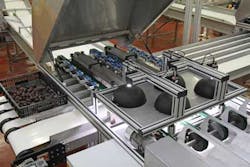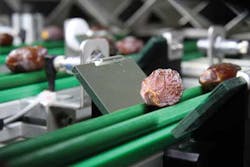FOOD INSPECTION: Automated system inspects dates at high speed
For thousands of years, dates have been a staple of the Middle Eastern diet. One of the most prized varieties—the Medjool date—is exceptionally large, being approximately 20 mm in diameter and 60 mm in length.
Depending on the picking season, these dates can range in color from yellow to dark brown or crimson. Medjool dates sometimes suffer from "loose skin," a separation of the skin from the flesh of the fruit that is usually correlated to sugar/moisture levels. Loose skin is an aesthetic defect rather than a taste defect, but it affects the fruit grade and, ultimately, the price.
After harvesting, Medjool dates must be inspected for weight, color, and amount of blistering present. In the past, inspection was manual and subject to human error. "Dates are tricky fruits to handle," says Liran Shahar, founder and chief executive officer of system solutions provider Com-N-Sense (Kfar Monash, Israel; www.com-n-sense.com). "They are sticky and vary in diameter and length, so they must be carefully separated and oriented before they can be inspected."
Com-N-Sense teamed up with Lugo Engineering (Talme Yaffe, Israel; www.lugo-engineering.co.il) to develop a system capable of automatic sorting of dates (Medjool and other types) at speeds as fast as 1400 dates/min. The novel date separation system is based on a series of V-shaped vibration feeders (see Fig. 1).
"After the dates are loaded onto these feeders," says Ofir Luk, founder of Lugo Engineering, "most of the dates will become properly separated and oriented. However, in some cases, dates may become attached to other dates along the feeder." An orifice the size of a date within the V-shaped feeder allows the dates to be separated. Dates falling through the V-shaped conveyor are then returned to the incoming feeder for reprocessing.
After separation, the dates are transferred from the feeder onto a conveyor that consists of two green polyester cords mounted in parallel (see Fig. 2). "Employing such a conveyor ensures that each of the separated dates will not roll or move as they enter the machine vision system," says Luk. To increase the number of dates that can be inspected, four lanes of feeders and conveyors are used to transport them at speeds as fast as six dates per second per lane.
Because the surfaces of the dates vary in both topology and color, even and uniform white lighting is needed to illuminate them. Four MB-DL406 MetaBright diffuse dome lights 4 in. in diameter from Metaphase (Bensalem, PA, USA) are installed on each machine. Coupled to each light, a 1280 × 960-pixel Prosilica 1290C GigE Vision color camera from Allied Vision Technologies (Stadtroda, Germany) fitted with an 8-mm lens from Computar (Commack, NY, USA) is used to image the dates.
As the dates pass through the imaging station, four optical switches trigger each of the cameras. Captured images are then transferred to a host PC over the GigE interface to a four-port network interface card (NIC) from Intel and into the host memory of the PC.
After capturing images of individual dates, each date must be segmented before image analysis can be performed. "Because the background image of the cords is green and the dates are generally of a reddish color, the red and green data from the captured RGB image can be used to separate the date from its background," says Shahar.
Once isolated, blister analysis on each date is performed by first converting the RGB data into HSI color space. Since the blister will appear in the image as a lighter color, analyzing the color edges of each fruit can determine the size and shape of each blister.
If these blisters are small and located in small areas across the date, it may be acceptable; large concentrated blister areas may be found unacceptable. Because these criteria are client dependent, a ruling system is embedded into the software that allows the client to combines several parameters into the date "grade" and sort the dates into different categories.
As each date is inspected on each of the four conveyors, specific features are identified and the date classified. While dates deemed to be acceptable pass through the machine, others are sorted onto the correct output conveyor via an array of five pneumatically controlled actuators, driven by a programmable logic controller (PLC) that is interfaced to the PC.
Com-N-Sense chose not to use off-the-shelf machine-vision software; the developers wrote the software themselves using some of the functions from Open Source Computer Vision software (OpenCV; http://opencv.willowgarage.com). According to Shahar, many off-the-shelf packages the company evaluated were not fast enough or they did not have the required functionality.
In the future, the two companies plans to add a weigh-in-motion component to the vision system that will allow the moisture of the dates to be determined. "By measuring the width and height of the dates as they pass through the inspection station, an approximate volume of the fruit can be calculated. Using the data in conjunction with the weight of the fruit will then determine the moisture and thus juicy nature of the fruit. Once determined, the dates can be sorted accordingly," says Shahar.


